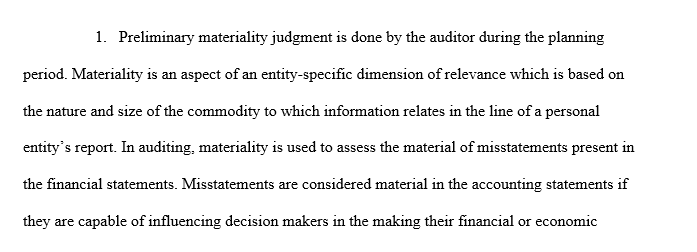How does the materiality of an item affect the acceptable and inherent risk borne
Discussion topic:
1. “Material” has a different definition in accounting than it does in everyday life. What does “material” mean in the context of an audit, and who determines whether an item is material? How does the materiality of an item affect the acceptable and inherent risk borne by an audited company?
Student Post
2. “Material” in accounting is considered an item that could make a difference. Different companies have different “materials” that could affect the bottom line. Obviously, the bigger the company, the greater the amount something would need to be considered a material item. Auditors make the decision as to whether or not a company has materiality and how much materiality may be involved in a company’s value. Investors take these types of judgments from auditors to determine if and how much money they should investing in a company. The idea is to determine if a company can pay back an investor if they decide to put money into said company.
Example of materiality in auditing for an investor: a company is deemed to have a value of $1 million. The owner of a larger company is thinking of buying this company. He can deem that he wants no more than 5 percent threshold in the evaluation of the company. if a $3,000 error is found, then it would be deemed immaterial and would not affect the investor’s decision. If that amount changes to $8,000 then it could affect the investor’s decision and that would be considered material towards the purchase for the investor.
3. A misstatement is considered “material” if it could affect a decision of a user of a financial statement. Accountants preparing financial information determines if an item is material. In another class that I took, I believe there is a limit of 5% that is provided by the government that helps guide firms in their judgement of material items. If an impact would be made on the statement that is important for users it is considered material. . An auditor is then responsible for gathering evidence, sample accounts, and monitor internal controls to determine if a company has prepared their financial statements with material misstatements. An auditor forms an opinion that gives reasonable assurance, not absolute, to financial readers about the validity of the financial statements.
I was surprised to learn how a CPA gathered some evidence. Pulling a sample from different accounts, like inventory, and verifying different parts of this account to determine if the company has been following GAAP guidelines. Random verification, in my opinion, helps to keep companies from falsifying information.
I did also read that fraud is hard if not impossible to detect since the purpose is for the company to get away with it. Auditors have to be diligent in their work while following guidelines to be sure they have conducted a fair and honest audit.
Answer preview to how does the materiality of an item affect the acceptable and inherent risk borne
APA
662 words


